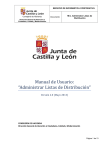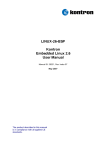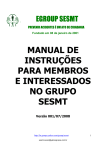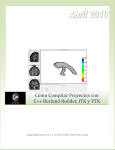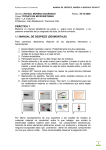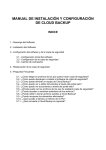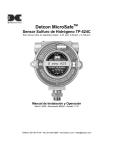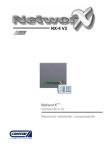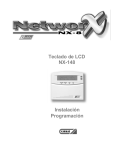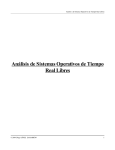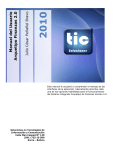Download Manual de Instalación de RTLinux
Transcript
Manual de Instalación de RTLinux Copyright (c) 2004 Diego LÓPEZ ZAMARRÓN Permission is granted to copy, distribute and/or modify this document under the terms of the GNU Free Documentation License, Version 1.2 or any later version published by the Free Software Foundation; with no Invariant Sections, no Front- Cover Texts, and no Back-Cover Texts. A copy of the license is included in the section entitled "GNU Free Documentation License". Instalación de RTLinux ...................................................................................... 1 1. Obtención de la distribución RTLinux y el código fuente de Linux....... 1 2. Copia del código fuente y la distribución .................................................. 1 3. Antes de comenzar con la instalación ........................................................ 2 4. Parcheado del Kernel .................................................................................. 3 5. Configuración del Kernel............................................................................ 3 6. Configuración del Gestor de arranque ...................................................... 4 7. Reiniciar el ordenador................................................................................. 6 8. Configurar RTLinux ................................................................................... 6 9. Compilar RTLinux ...................................................................................... 6 10. Fin. Ya tiene su sistema de Tiempo Real Linux instalado. .................... 6 Anexo: GNU Free Documentat ion License...................................................... 7 Manual de Instalación de RTLinux Instalación de RTLinux 1. Obtención de la distribución RTLinux y el código fuente de Linux Es necesario disponer del código fuente del kernel de Linux y de una distribución de RTLinux. Nota: Las distribuciones de RTLinux no son validas para todos las versiones del kernel de Linux. Soportan al menos las versiones 2.2.x y 2.4.x. Mas adelante se explica como se comprueba si es valida. En el caso del código fuente de Linux se puede obtener desde www.kernel.org o en los cedes de alguna de las distribuciones de Linux. Para obtener la distribución de RTLinux deberemos acceder a www.fsmlabs.com/products/openrtlinux/, rellenar un formulario y con ello podremos descargarnos la última versión de RTLinux bajo la licencia GNU/GPL v2. 2. Copia del código fuente y la distribución El código fuente de Linux normalmente se encuentra en el directorio /usr/src/linux, que normalmente también es un enlace al directorio /usr/src/linux.2.*.* que contiene la versión del kernel instalada. 2.1. Si la versión descargada es igual a la que tenemos no haremos nada y pasaremos al siguiente punto. En caso contrario sería conveniente guardar la versión antigua. Si esta con la estructura de directorios anterior no hace falta hacer nada, pero sino se haría: cp linux linux.old 2.2. Descomprimimos la versión descargada de Linux. cd /usr/src/ tar xzf linux.2.x.y.tar.gz Al realizar esto se ha creado un nuevo directorio /usr/src/linux.2.x.y correspondiente a la versión descargada. Ahora modificamos el enlace /usr/src/linux para que apunte a /usr/src/linux.2.x.y 2.3. Descomprimimos la distribución RTLinux cd /usr/src/ tar xzf rtlinux-3.*.tar.gz © 2004 Diego LÓPEZ ZAMARRÓN 1 Manual de Instalación de RTLinux Al realizar esto se ha creado un nuevo directorio /usr/src/rtlinux-3.*. Por comodidad podemos crear un enlace /usr/src/rtlinux que apunte a /usr/src/rtlinux.3.*. cd /usr/src ln –sf /usr/src/rtlinux-3.* ./rtlinux Al realizar todo esto no ha quedado la siguiente estructura de directorios /usr/src/linux /usr/src/linux.2.*.* /usr/src/linux.2.x.y /usr/src/rtlinux /usr/src/rtlinux-3.* De ahora en adelante cuando queramos acceder al directorio del código fuente de Linux accederemos mediante /usr/src/linux y para acceder a la distribución de RTLinux lo haremos mediante /usr/src/rtlinux. 2.4. Enlazar RTLinux con Linux cd /usr/src/rtlinux ln –sf /usr/src/linux ./linux Al realizar esto se crea un nuevo directorio (usr/src/rtlinux/linux), que es un enlace al código fuente de Linux. 3. Antes de comenzar con la instalación 3.1. Ahora comprobamos si la versión de la distribución de RTLinux que nos hemos descargado soporta la versión del kernel que queremos configurar y que también hemos obtenido. Para ello escribimos: cd /usr/src/rtlinux grep –A 2 “^\W*VERSION” ./patches/kernel_patch* La salida de este comando es: kernel_patch-2.2: kernel_patch-2.2kernel_patch-2.2--kernel_patch-2.4: kernel_patch-2.4kernel_patch-2.4- VERSION = 2 PATCHLEVEL = 2 SUBLEVEL = 17 VERSION = 2 PATCHLEVEL = 4 SUBLEVEL = 0 El significado de esto es que la versión de esta distribución de RTLinux es valida para la versión del Kernel 2.2.17 y 2.4.0 © 2004 Diego LÓPEZ ZAMARRÓN 2 Manual de Instalación de RTLinux 3.2. Comprobamos también si disponemos del compilador adecuado. Para ello escribimos: gcc –v Debemos comprobar que al menos tenemos la versión 2.7.2.3 ó superior de gcc y la 1.1.2 ó superior de egcs. Si no lo tenemos podemos compilarlo con otro compilador pero no esta testeado. 4. Parcheado del Kernel La instalación de RTLinux consiste en parchear el código fuente de Linux. El parche que usaremos es el valido para nuestro kernel, comprobado en el punto anterior. Para ello usaremos el comando patch. Para saber más sobre este comando escribe: man patch Para parchear escribimos: cd /usr/src/linux match –p1 < /usr/src/RTLinux/patches/kernel_patch-2.*.* donde kernel_patch-2.*.* se corresponde con el parche que vamos a aplicar a nuestro kernel. 5. Configuración del Kernel Ahora configuraremos el kernel, lo compilaremos y obtendremos la imagen de nuestro Linux con Tiempo Real. Nota: Si nunca antes has compilado un kernel ten en cuenta que el tiempo depende de la maquina que dispongas y que puede ser un proceso largo. Nota: En este punto debería consultar información acerca de las opciones de configuración del kernel si le son desconocidas. Escribe: cd /usr/src/linux make mrproper make config ó make menuconfig ó make xconfig Nota: Hay unas opciones importantes que se deben configurar adecuadamente para que el sistema RTLinux funcione adecuadamente y son: - Especificar correctamente el tipo de CPU que disponemos. Ejemplo. Pentium MMX. - Si solo disponemos de una CPU, desactivar el soporte para SMP © 2004 Diego LÓPEZ ZAMARRÓN 3 Manual de Instalación de RTLinux - No activar el soporte de APM. APM BIOS Call puede producir efectos impredecibles en el rendimiento de un sistema de tiempo real. Una vez configurado adecuadamente nuestro kernel continuamos. make make make make dep bzImage modules modules_install Como resultado de estos comando hemos obtenido nuestra imagen y se encuentra en /usr/src/linux/arch/i386/boot y se llama bzImage. Esta imagen es la que debemos arrancar para tener nuestro Sistema de Tiempo Real Linux. 6. Configuración del Gestor de arranque Describo el proceso de configuración para los gestores de arranque LiLo y Grub. Antes de nada copiamos la imagen de arranque creada anteriormente al directorio /boot. cp /usr/src/linux/arch/i386/boot/bzImage /boot/rtzImage Nota: El formato de los ficheros de configuración puede cambiar según la distribución de Linux que se use, y según la versión del gestor que se use, por lo que es recomendable consultar la documentación para verificar el formato a usar en su sistema. Nota: Lo importante de este apartado es que se debe crear una entrada en el fichero de configuración correspondiente para la nueva imagen del kernel que se quiere poder arrancar y que es distinta de la que actualmente estamos usando. LiLo - Abrimos el fichero de configuración de LiLo: /etc/lilo.conf Añadimos la siguiente entrada al fichero image = /boot/rtzImage label = rtlinux read-only root = /dev/hda1 (el valor correspondiente a la partición donde se encuentre sus sistema Linux) - Escribe en la consola /sbin/lilo Comprueba la salida de este comando por si existen errores. Debería ser del estilo de: Added linux * Added rtlinux El resultado final debería ser parecido a este: © 2004 Diego LÓPEZ ZAMARRÓN 4 Manual de Instalación de RTLinux prompt timeout = 50 default = linux boot=/dev/hda map=/boot/map install=/boot/boot.b message=/boot/message linear image = /boot/vmlinuz label=Linux initrd=/boot/initrd.img read-only root = /dev/hda1 image = /boot/rtzImage label=RTLinux initrd=/boot/initrd.img read-only root = /dev/hda1 Grub - Abrimos el fichero de configuración de Grub: /boot/grub/menu.lst Añadimos la siguiente entrada: title Rtlinux kernel (hd0,0)/boot/rtzImage root=/dev/hda1 vga=0x307 splash=silent showopts initrd (hd0,0)/boot/initrd El resultado final debería ser parecido a este: color white/blue black/light-gray default 0 gfxmenu (hd0,0)/boot/message timeout 5 title linux kernel (hd0,0)/boot/vmlinuz root=/dev/hda1 vga=0x307 splash=silent showopts initrd (hd0,0)/boot/initrd title floppy root (fd0) chainloader +1 title failsafe kernel (hd0,0)/boot/vmlinuz.shipped root=/dev/hda1 showopts ide=nodma apm=off acpi=off vga=normal nosmp noapic maxcpus=0 3 initrd (hd0,0)/boot/initrd.shipped title Rtlinux kernel (hd0,0)/boot/rtzImage root=/dev/hda1 vga=0x307 splash=silent showopts initrd (hd0,0)/boot/initrd © 2004 Diego LÓPEZ ZAMARRÓN 5 Manual de Instalación de RTLinux Ya tenemos configurado el gestor de arranque de nuestra maquina. Obsérvese que no se ha configurado como kernel por defecto. Para ello en LiLo se debe poner el valor adecuado a la etiqueta default y ejecutar /sbin/lilo y en Grub modificar el valor de la etiqueta default por el adecuado teniendo en cuenta que comienza por 0. 7. Reiniciar el ordenador Al reiniciar y mostrarnos el gestor de arranque las opciones, sino hemos configurado el nuevo kernel por defecto deberemos seleccionarle para arrancar con él. 8. Configurar RTLinux El proceso es similar al de configuración del kernel. cd /usrc/src/rtlinux make config ó make menuconfig ó make xconfig Nota: En este punto se pueden configurar cosas como Activar las señales ó relojes Posix.. 9. Compilar RTLinux make make devices make install 10. Fin. Ya tiene su sistema de Tiempo Real Linux instalado. © 2004 Diego LÓPEZ ZAMARRÓN 6 Manual de Instalación de RTLinux Anexo: GNU Free Documentat ion License GNU Free Documentation License Version 1.2, November 2002 Copyright (C) 2000,2001,2002 Free Software Foundation, Inc. 59 Temple Place, Suite 330, Boston, MA 02111-1307 USA Everyone is permitted to copy and distribute verbatim copies of this license document, but changing it is not allowed. 0. PREAMBLE The purpose of this License is to make a manual, textbook, or other functional and useful document "free" in the sense of freedom: to assure everyone the effective freedom to copy and redistribute it, with or without modifying it, either commercially or noncommercially. Secondarily, this License preserves for the author and publisher a way to get credit for their work, while not being considered responsible for modifications made by others. This License is a kind of "copyleft", which means that derivative works of the document must themselves be free in the same sense. It complements the GNU General Public License, which is a copyleft license designed for free software. We have designed this License in order to use it for manuals for free software, because free software needs free documentation: a free program should come with manuals providing the same freedoms that the software does. But this License is not limited to software manuals; it can be used for any textual work, regardless of subject matter or whether it is published as a printed book. We recommend this License principally for works whose purpose is instruction or reference. 1. APPLICABILITY AND DEFINITIONS This License applies to any manual or other work, in any medium, that contains a notice placed by the copyright holder saying it can be distributed under the terms of this License. Such a notice grants a world-wide, royalty- free license, unlimited in duration, to use that work under the conditions stated herein. The "Document", below, refers to any such manual or work. Any member of the public is a licensee, and is addressed as "you". You accept the license if you copy, modify or distribute the work in a way requiring permission under copyright law. A "Modified Version" of the Document means any work containing the Document or a portion of it, either copied verbatim, or with modifications and/or translated into another language. A "Secondary Section" is a named appendix or a front-matter section of the Document that deals exclusively with the relationship of the publishers or authors of the Document to the Document's overall subject (or to related matters) and contains nothing that could fall directly within that overall subject. (Thus, if the Document is in part a textbook of mathematics, a Secondary Section may not explain any mathematics.) The relationship could be a matter of historical connection with the subject or with related matters, or of legal, commercial, philosophical, ethical or political position regarding them. The "Invariant Sections" are certain Secondary Sections whose titles are designated, as being those of Invariant Sections, in the notice that says that the Document is released under this License. If a section does not fit the above definition of Secondary then it is not allowed to be designated as Invariant. The Document may contain zero Invariant Sections. If the Document does not identify any Invariant Sections then there are none. The "Cover Texts" are certain short passages of text that are listed, as Front- Cover Texts or Back-Cover Texts, in the notice that says that the Document is released under this License. A Front- Cover Text may be at most 5 words, and a Back-Cover Text may be at most 25 words. A "Transparent" copy of the Document means a machine- readable copy, represented in a format whose specification is available to the general public, that is suitable for revising the document straightforwardly with generic text editors or (for images composed of pixels) generic paint programs or (for drawings) some widely available drawing editor, and that is suitable for input to text formatters or for automatic translation to a variety of formats suitable for input to text formatters. A copy made in an otherwise Transparent file format whose markup, or absence of markup, has been arranged to thwart or discourage subsequent modification by readers is not Transparent. An image format is not Transparent if used for any substantial amount of text. A copy that is not "Transparent" is called "Opaque". Examples of suitable formats for Transparent copies include plain ASCII without markup, Texinfo input format, LaTeX input format, SGML or XML using a publicly available DTD, and estandard- conforming simple HTML, PostScript or PDF designed for human modification. Examples of transparent image formats include PNG, XCF and JPG. Opaque formats include proprietary formats that can be read and edited only by proprietary word processors, © 2004 Diego LÓPEZ ZAMARRÓN 7 Manual de Instalación de RTLinux SGML or XML for which the DTD and/or processing tools are not generally available, and the machine- generated HTML, PostScript or PDF produced by some word processors for output purposes only. The "Title Page" means, for a printed book, the title page itself, plus such following pages as are needed to hold, legibly, the material this License requires to appear in the title page. For works in formats which do not have any title page as such, "Title Page" means the text near the most prominent appearance of the work's title, preceding the beginning of the body of the text. A section "Entitled XYZ" means a named subunit of the Document whose title either is precisely XYZ or contains XYZ in parentheses following text that translates XYZ in another language. (Here XYZ stands for a specific section name mentioned below, such as "Acknowledgements", "Dedications", "Endorsements", or "History".) To "Preserve the Title" of such a section when you modify the Document means that it remains a section "Entitled XYZ" according to this definition. The Document may include Warranty Disclaimers next to the notice which states that this License applies to the Document. These Warranty Disclaimers are considered to be included by reference in this License, but only as regards disclaiming warranties: any other implication that these Warranty Disclaimers may have is void and has no effect on the meaning of this License. 2. VERBATIM COPYING You may copy and distribute the Document in any medium, either commercially or noncommercially, provided that this License, the copyright notices, and the license notice saying this License applies to the Document are reproduced in all copies, and that you add no other conditions whatsoever to those of this License. You may not use technical measures to obstruct or control the reading or further copying of the copies you make or distribute. However, you may accept compensation in exchange for copies. If you distribute a large enough number of copies you must also follow the conditions in section 3. You may also lend copies, under the same conditions stated above, and you may publicly display copies. 3. COPYING IN QUANTITY If you publish printed copies (or copies in media that commonly have printed covers) of the Document, numbering more than 100, and the Document's license notice requires Cover Texts, you must enclose the copies in covers that carry, clearly and legibly, all these Cover Texts: Front- Cover Texts on the front cover, and Back-Cover Texts on the back cover. Both covers must also clearly and legibly identify you as the publisher of these copies. The front cover must present the full title with all words of the title equally prominent and visible. You may add other material on the covers in addition. Copying with changes limited to the covers, as long as they preserve the title of the Document and satisfy these conditions, can be treated as verbatim copying in other respects. If the required texts for either cover are too voluminous to fit legibly, you should put the first ones listed (as many as fit reasonably) on the actual cover, and continue the rest onto adjacent pages. If you publish or distribute Opaque copies of the Document numbering more than 100, you must either include a machine- readable Transparent copy along with each Opaque copy, or state in or with each Opaque copy a computernetwork location from which the general network- using public has access to download using public-estandard network protocols a complete Transparent copy of the Document, free of added material. If you use the latter option, you must take reasonably prudent steps, when you begin distribution of Opaque copies in quantity, to ensure that this Transparent copy will remain thus accessible at the stated location until at least one year after the last time you distribute an Opaque copy (directly or through your agents or retailers) of that edition to the public. It is requested, but not required, that you contact the authors of the Document well before redistributing any large number of copies, to give them a chance to provide you with an updated version of the Document. 4. MODIFICATIONS You may copy and distribute a Modified Version of the Document under the conditions of sections 2 and 3 above, provided that you release the Modified Version under precisely this License, with the Modified Version filling the role of the Document, thus licensing distribution and modification of the Modified Version to whoever possesses a copy of it. In addition, you must do these things in the Modified Version: © 2004 Diego LÓPEZ ZAMARRÓN 8 Manual de Instalación de RTLinux A. Use in the Title Page (and on the covers, if any) a title distinct from that of the Document, and from those of previous versions (which should, if there were any, be listed in the History section of the Document). You may use the same title as a previous version if the original publisher of that version gives permission. B. List on the Title Page, as authors, one or more persons or entities responsible for authorship of the modifications in the Modified Version, together with at least five of the principal authors of the Document (all of its principal authors, if it has fewer than five), unless they release you from this requirement. C. State on the Title page the name of the publisher of the Modified Version, as the publisher. D. Preserve all the copyright notices of the Document. E. Add an appropriate copyright notice for your modifications adjacent to the other copyright notices. F. Include, immediately after the copyright notices, a license notice giving the public permission to use the Modified Version under the terms of this License, in the form shown in the Addendum below. G. Preserve in that license notice the full lists of Invariant Sections and required Cover Texts given in the Document's license notice. H. Include an unaltered copy of this License. I. Preserve the section Entitled "History", Preserve its Title, and add to it an item stating at least the title, year, new authors, and publisher of the Modified Version as given on the Title Page. If there is no section Entitled "History" in the Document, create one stating the title, year, authors, and publisher of the Document as given on its Title Page, then add an item describing the Modified Version as stated in the previous sentence. J. Preserve the network location, if any, given in the Document for public access to a Transparent copy of the Document, and likewise the network locations given in the Document for previous versions it was based on. These may be placed in the "History" section. You may omit a network location for a work that was published at least four years before the Document itself, or if the original publisher of the version it refers to gives permission. K. For any section Entitled "Acknowledgements" or "Dedications", Preserve the Title of the section, and preserve in the section all the substance and tone of each of the contributor acknowledgements and/or dedications given therein. L. Preserve all the Invariant Sections of the Document, unaltered in their text and in their titles. Section numbers or the equivalent are not considered part of the section titles. M. Delete any section Entitled "Endorsements". Such a section may not be included in the Modified Version. N. Do not retitle any existing section to be Entitled "Endorsements" or to conflict in title with any Invariant Section. O. Preserve any Warranty Disclaimers. If the Modified Version includes new front-matter sections or appendices that qualify as Secondary Sections and contain no material copied from the Document, you may at your option designate some or all of these sections as invariant. To do this, add their titles to the list of Invariant Sections in the Modified Version's license notice. These titles must be distinct from any other section titles. You may add a section Entitled "Endorsements", provided it contains nothing but endorsements of your Modified Version by various parties- -for example, statements of peer review or that the text has been approved by an organization as the authoritative definition of a estandard. You may add a passage of up to five words as a Front- Cover Text, and a passage of up to 25 words as a Back-Cover Text, to the end of the list of Cover Texts in the Modified Version. Only one passage of Front- Cover Text and one of Back-Cover Text may be added by (or through arrangements made by) any one entity. If the Document already includes a cover text for the same cover, previously added by you or by arrangement made by the same entity you are acting on behalf of, you may not add another; but you may replace the old one, on explicit permission from the previous publisher that added the old one. The author(s) and publisher(s) of the Document do not by this License give permission to use their names for publicity for or to assert or imply endorsement of any Modified Version. 5. COMBINING DOCUMENTS You may combine the Document with other documents released under this License, under the terms defined in section 4 above for modified versions, provided that you include in the combination all of the Invariant Sections of all of the original documents, unmodified, and list them all as Invariant Sections of your combined work in its license notice, and that you preserve all their Warranty Disclaimers. The combined work need only contain one copy of this License, and multiple identical Invariant Sections may be replaced with a single copy. If there are multiple Invariant Sections with the same name but different contents, make the title of each such section unique by adding at the end of it, in parentheses, the name of the original author or publisher of that section if known, or else a unique number. Make the same adjustment to the section titles in the list of Invariant Sections in the license notice of the combined work. In the combination, you must combine any sections Entitled "History" in the various original documents, forming one section Entitled "History"; likewise combine any sections Entitled "Acknowledgements", and any sections Entitled "Dedications". You must delete all sections Entitled "Endorsements". © 2004 Diego LÓPEZ ZAMARRÓN 9 Manual de Instalación de RTLinux 6. COLLECTIONS OF DOCUMENTS You may make a collection consisting of the Document and other documents released under this License, and replace the individual copies of this License in the various documents with a single copy that is included in the collection, provided that you follow the rules of this License for verbatim copying of each of the documents in all other respects. You may extract a single document from such a collection, and distribute it individually under this License, provided you insert a copy of this License into the extracted document, and follow this License in all other respects regarding verbatim copying of that document. 7. AGGREGATION WITH INDEPENDENT WORKS A compilation of the Document or its derivatives with other separate and independent documents or works, in or on a volume of a storage or distribution medium, is called an "aggregate" if the copyright resulting from the compilation is not used to limit the legal rights of the compilation's users beyond what the individual works permit. When the Document is included in an aggregate, this License does not apply to the other works in the aggregate which are not themselves derivative works of the Document. If the Cover Text requirement of section 3 is applicable to these copies of the Document, then if the Document is less than one half of the entire aggregate, the Document's Cover Texts may be placed on covers that bracket the Document within the aggregate, or the electronic equivalent of covers if the Document is in electronic form. Otherwise they must appear on printed covers that bracket the whole aggregate. 8. TRANSLATION Translation is considered a kind of modification, so you may distribute translations of the Document under the terms of section 4. Replacing Invariant Sections with translations requires special permission from their copyright holders, but you may include translations of some or all Invariant Sections in addition to the original versions of these Invariant Sections. You may include a translation of this License, and all the license notices in the Document, and any Warranty Disclaimers, provided that you also include the original English version of this License and the original versions of those notices and disclaimers. In case of a disagreement between the translation and the original version of this License or a notice or disclaimer, the original version will prevail. If a section in the Document is Entitled "Acknowledgements", "Dedications", or "History", the requirement (section 4) to Preserve its Title (section 1) will typically require changing the actual title. 9. TERMINATION You may not copy, modify, sublicense, or distribute the Document except as expressly provided for under this License. Any other attempt to copy, modify, sublicense or distribute the Document is void, and will automatically terminate your rights under this License. However, parties who have received copies, or rights, from you under this License will not have their licenses terminated so long as such parties remain in full compliance. 10. FUTURE REVISIONS OF THIS LICENSE The Free Software Foundation may publish new, revised versions of the GNU Free Documentation License from time to time. Such new versions will be similar in spirit to the present version, but may differ in detail to address new problems or concerns. See http://www.gnu.org/copyleft/. Each version of the License is given a distinguishing version number. If the Document specifies that a particular numbered version of this License "or any later version" applies to it, you have the option of following the terms and conditions either of that specified version or of any later version that has been published (not as a draft) by the Free Software Foundation. If the Document does not specify a version number of this License, you may choose any version ever published (not as a draft) by the Free Software Foundation. © 2004 Diego LÓPEZ ZAMARRÓN 10 Manual de Instalación de RTLinux ADDENDUM: How to use this License for your documents To use this License in a document you have written, include a copy of the License in the document and put the following copyright and license notices just after the title page: Copyright (c) YEAR YOUR NAME. Permission is granted to copy, distribute and/or modify this document under the terms of the GNU Free Documentation License, Version 1.2 or any later version published by the Free Software Foundation; with no Invariant Sections, no Front- Cover Texts, and no Back-Cover Texts. A copy of the license is included in the section entitled "GNU Free Documentation License". If you have Invariant Sections, Front- Cover Texts and Back-Cover Texts, replace the "with...Texts." line with this: with the Invariant Sections being LIST THEIR TITLES, with the Front- Cover Texts being LIST, and with the Back-Cover Texts being LIST. If you have Invariant Sections without Cover Texts, or some other combination of the three, merge those two alternatives to suit the situation. If your document contains nontrivial examples of program code, we recommend releasing these examples in parallel under your choice of free software license, such as the GNU General Public License, to permit their use in free software. © 2004 Diego LÓPEZ ZAMARRÓN 11














